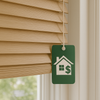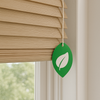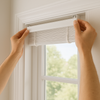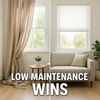Are Eco-Friendly Blinds Really Sustainable, or Just Marketing Hype?
- by Mariam Labadze
Quick Answer
Genuine eco-friendly blinds exist but require scrutiny separating authentic sustainability from greenwashing marketing. True sustainable options feature verifiable certifications (FSC for wood, OEKO-TEX for fabrics, Cradle to Cradle), use renewable materials like bamboo or organic fabrics, avoid VOC emissions, and demonstrate transparent supply chains. However, many "eco-friendly" claims lack substance—vague terms like "natural" or "green" without certification, minor sustainable components in otherwise conventional products, or misleading lifecycle claims. Real sustainability considers material sourcing, manufacturing processes, durability, and end-of-life disposal. Quality sustainable blinds from reputable suppliers deliver genuine environmental benefits through responsibly sourced materials, reduced chemical use, and extended lifespans minimizing waste.
Understanding Greenwashing in Window Treatments
Vague Eco-Claims – Terms like "eco-friendly," "natural," or "green" sound appealing but mean nothing without specifics. Marketing departments liberally apply these labels to conventional products with minimal environmental credentials, hoping consumers won't demand proof beyond pleasant-sounding descriptions.
Watch for qualifiers suggesting partial rather than comprehensive sustainability—"made with recycled content" might mean 5% recycled materials in otherwise conventional products. This technically accurate but misleading phrasing creates green impressions exceeding actual environmental benefits.
Cherry-Picked Attributes – Companies highlight single sustainable aspects whilst ignoring problematic practices elsewhere. Perhaps bamboo slats receive emphasis whilst toxic adhesives, unsustainable packaging, and carbon-intensive shipping get conveniently ignored. Comprehensive sustainability requires examining entire lifecycles, not cherry-picked favorable elements.
Meaningless Certifications – Some companies create official-looking logos and certifications that actually mean nothing—internal standards lacking third-party verification or industry recognition. Genuine certifications come from independent organizations with transparent standards and verification processes.
Legitimate Sustainability Certifications
FSC (Forest Stewardship Council) – The gold standard for wood products, FSC certification verifies timber from responsibly managed forests where harvesting doesn't exceed growth rates, biodiversity receives protection, and workers earn fair wages. This comprehensive certification transforms wood from potentially problematic material into genuinely sustainable choice when properly sourced.
FSC comes in three levels: FSC 100% (entirely certified wood), FSC Mixed (certified wood combined with controlled sources), and FSC Recycled (reclaimed timber). All three represent legitimate sustainability improvements over uncertified alternatives.
OEKO-TEX Standard 100 – Certifies fabrics tested for harmful substances including heavy metals, pesticides, VOCs, and allergens. Products meeting OEKO-TEX standards won't negatively impact health through chemical exposure—critical for window treatments in bedrooms and living spaces where air quality affects wellbeing.
This certification prevents companies claiming "natural fabrics" whilst using conventional cotton grown with intensive pesticides or applying toxic finishing treatments that negate natural fiber benefits.
Cradle to Cradle Certified – Perhaps the most comprehensive sustainability certification, Cradle to Cradle evaluates products across five categories: material health, material reuse, renewable energy use, water stewardship, and social fairness. Achieving this certification requires demonstrating genuine sustainability throughout entire lifecycles.
Products at Basic, Bronze, Silver, Gold, or Platinum levels all represent meaningful sustainability improvements over conventional alternatives, though higher levels demand increasingly rigorous standards.
Truly Sustainable Materials
Bamboo – Fast-growing bamboo regenerates without replanting, reaches harvest maturity in 3-5 years versus decades for hardwoods, and grows without pesticides or fertilizers. These characteristics make bamboo genuinely sustainable when sourced from certified responsible plantations rather than problematic monocultures.
However, bamboo processing significantly affects environmental impact. Look for bamboo products using mechanical rather than chemical processing methods, avoiding the toxic chemicals that some bamboo textile production involves.
Organic Fabrics – GOTS-certified organic cotton, linen, and hemp represent genuine sustainable alternatives to conventional textiles. Organic cultivation eliminates synthetic pesticides and fertilizers that contaminate water, harm ecosystems, and leave chemical residues affecting indoor air quality.
The "organic" designation alone proves insufficient—GOTS certification verifies organic status throughout supply chains whilst ensuring fair labor practices and prohibiting harmful processing chemicals that might compromise organic fiber benefits.
Recycled Materials – Blinds incorporating post-consumer recycled content reduce demand for virgin materials whilst diverting waste from landfills. However, scrutinize recycled content percentages—products with 10% recycled content offer minimal environmental benefits compared to those with 80%+ recycled composition.
Recycled aluminum in venetian blinds represents particularly strong sustainability since aluminum recycles infinitely without quality degradation whilst requiring 95% less energy than producing virgin aluminum.
Natural Wood with Low-VOC Finishes – FSC-certified wood finished with water-based or natural oil treatments avoids the VOC emissions and environmental impact of conventional lacquers. These gentle finishing methods protect wood whilst maintaining indoor air quality and reducing manufacturing environmental footprints.
Manufacturing and Transportation Impact
Material sourcing represents only partial sustainability—manufacturing processes and transportation significantly affect environmental footprints. Products manufactured using renewable energy, with waste reduction programs, and employing fair labor practices demonstrate comprehensive sustainability commitments.
Local or regional manufacturing reduces transportation emissions dramatically. UK-made blinds traveling hundreds of kilometers create far smaller carbon footprints than imports shipped thousands of miles from distant manufacturing centers, even when materials themselves prove sustainable.
Companies transparent about manufacturing locations, energy sources, and labor practices signal genuine sustainability commitments. Those providing vague information or deflecting questions about production likely have environmental or ethical practices they prefer hiding.
Durability: The Often-Overlooked Sustainability Factor
The most sustainable blind proves to be the one you don't need replacing frequently. Quality construction ensuring 10-15 year lifespans delivers greater environmental benefits than cheaper alternatives requiring replacement every 3-5 years, regardless of materials involved.
This perspective challenges purely material-focused sustainability thinking. A well-made conventional blind lasting twice as long as poorly constructed "eco-friendly" alternatives may ultimately prove more sustainable through reduced replacement frequency and associated manufacturing, transportation, and disposal impacts.
Evaluate warranties as durability indicators—manufacturers confident in longevity offer substantial warranties, whilst short warranty periods suggest expected deterioration requiring replacement before warranty expiration.
End-of-Life Considerations
Comprehensive sustainability considers product disposal after useful life ends. Biodegradable materials decompose naturally, whilst recyclable components can become new products rather than persisting in landfills indefinitely.
Some progressive companies offer take-back programs collecting old blinds for recycling or refurbishment. These circular economy initiatives represent advanced sustainability thinking, closing loops that traditional linear "make-use-dispose" models leave open.
Products designed for disassembly allow separating components—recyclable metals, compostable fabrics, reusable hardware—rather than creating inseparable combinations destined for landfills regardless of individual material recyclability.
Questions to Ask Before Buying
What specific certifications verify sustainability claims? Can you provide documentation proving certification validity? These questions separate genuine sustainability from marketing fluff—legitimate companies readily provide certification details whilst vague responders likely lack substantive credentials.
Where are products manufactured, and under what environmental and labor standards? Companies proud of practices gladly share information, whilst those deflecting probably have practices they'd rather keep hidden.
What's the expected lifespan under normal use, and what warranty backs these expectations? This reveals whether products truly deliver the durability that represents core sustainability through extended use reducing replacement frequency.
What happens at end-of-life? Are materials recyclable, biodegradable, or does the company offer take-back programs? Forward-thinking sustainability considers entire lifecycles, not just production and use phases.
Making Informed Decisions
Prioritize certifications over marketing language. Official third-party certifications require meeting verifiable standards and undergoing independent audits. Marketing terms require nothing beyond creative copywriting, making certifications vastly more reliable sustainability indicators.
Research companies' broader environmental commitments beyond individual products. Do they demonstrate consistent sustainability focus across operations, or do "eco-friendly" product lines exist alongside conventional offerings with no environmental consideration? Comprehensive commitment suggests genuine values rather than opportunistic marketing.
Balance sustainability with functionality and budget. Perfect sustainability shouldn't prevent good—modest improvements prove better than no improvements, and practical considerations ensure you'll actually use purchases rather than returning them when they fail meeting needs despite environmental credentials.
At 1 Click Blinds, we're committed to transparency about our products' environmental impacts. Where we offer genuine sustainable options with verified certifications, we're proud sharing details. Where products don't meet sustainability standards, we acknowledge this honestly rather than applying meaningless green marketing. This integrity helps you making truly informed decisions supporting your environmental values.







